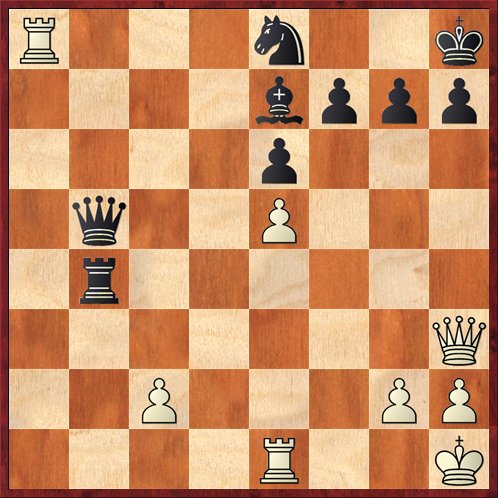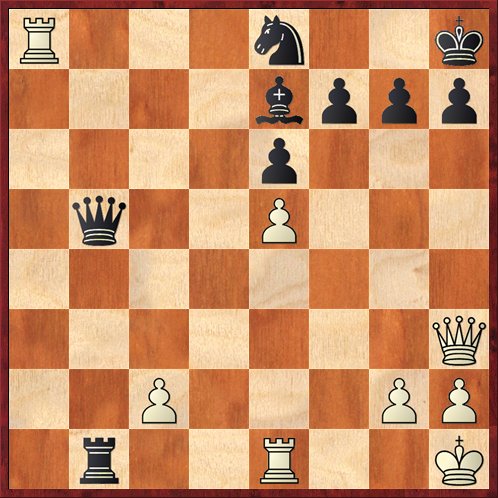Yesterday we had a rather small crew at the Aptos Public Library chess club — only six kids. But it was a good group, and we had some well-played and competitive games.
During lesson time I put up the following position, #281 in John Emms’ Ultimate Chess Puzzle Book:
White to move.
Like all the positions in Emms’ book, this one is from an actual game, Szelag-Stefansson, Capelle la Grande 2000.
I thought this one might be a little bit difficult for our group, but they really nailed it. First Aaron pointed out that White has an “almost-checkmate.” What is it, I asked? He said Rxe8+. And why is it only an almost-checkmate? Because Black can interpose his bishop on f8.
At this point a couple kids clamored out that there was a better move. Queen takes e8! I congratulated them on this find, and said, “Now when you see an almost-checkmate on the board, you should try to figure out ways to make it a real checkmate. What if we could find a way to move Black’s queen, or get him to move it, so that it’s not defending the knight any more?”
I thought that it would take a while for them to figure out, but almost immediately Anton came up with the idea: “Sacrifice the queen with 1. Qd3!” Just to make sure he saw the correct idea, I asked, what will you do if he takes the queen? And Anton said without hesitation, “Rook takes e8 check!” Again I complimented him and pointed out that even though 1. Qd3 Qxd3 2. cd is okay (it wins a piece after all), you want to play for checkmate if you can.
Now I asked them for defenses for Black, and we quickly decided that 1. … Qc6 was the only viable possibility. Again I thought it might take them a while to figure out what comes next for White, but it was less than thirty seconds before 2. Qa6 was suggested. We then played through 2. … Qd7 3. Qc8 and agreed that White was winning at least a piece. (Emms says in his book that 2. Qa6 was actually played in the game, but 2. Qf3 is even stronger, when 2. … Qd7 is met by 3. Qxf7. However, in this case I felt that the kids’ solution was good enough — in fact, it’s probably what I would have played.)
At this point I was going to bring the lesson to an end, but Aaron asked if we could go back to the original position again. I forget exactly what his question was, but it amounted to asking what Black could have done if it was his move.
“What a great question!” I said. “Does anyone have any suggestions?” And very quickly someone (probably Aaron) suggested 1. … Rb8, leading to the position below.
White to move.
At first I complimented this move because Black is playing aggressively. Two can play this game of setting up almost-checkmates!
Then I noticed that there is a big tactical hole in this idea, and I asked the kids how they would respond as White.
But here I had another surprise. (Teaching is full of surprises!) The group just couldn’t find it. I think that part of the problem was that they were tired. After we solved the first puzzle, four of them sort of checked out of the discussion (well, to be honest there was one kid who had never been paying attention), so the only two who were really trying to solve the position were Aaron and Anton. But no matter how many hints I dropped, some of them very obvious (“Always look for checks and captures!”) neither of them could figure out 2. Rxe8+ Qxe8 3. Rxb1, winning a piece.
I remembered an earlier blog post where I wrote about a lesson in which I was surprised at the kids’ difficulty with an obvious position, and I had reached the conclusion then that you can’t expect them to know something if you haven’t taught it to them before. Sometimes kids pick things up by osmosis and sometimes they amaze you with the things that they know, but you just can’t always count on that. In this case, I realized that I had never taught them about overloads before, and so they did not realize it was a danger signal that the Black queen is defending two pieces.
However, my favorite point of the whole lesson came when I played the moves 2. Rxe8+ Qxe8 and Anton finally saw the point, saw the rook unguarded on b1, and he said, “Oh!” It’s one of those moments you live for as a teacher, the Moment of Sudden Understanding. You don’t get those too often.
What a great lesson! I learned a lot, too.
- You can get two lessons for the price of one after solving a White-to-play-and-win problem by asking what Black could do to defend if it were his move.
- Although kids will amaze you with the things they know, you still can’t expect them to know something you haven’t taught them.
- There’s nothing obvious about overloads. I need to teach a lesson about them.
By the way, another good thing about yesterday’s group is that for the first time in history, we had as many girls as boys (three and three). Although that was really exciting, it would have been better if we had had, say, five and five or six and six. But oh well, you can’t expect miracles.





{ 4 comments… read them below or add one }
Dana, Part II of the Best of Chess Blogging
is now posted. Your posts will mostly be in the next part, the thing was getting looong… 🙂
Typo: “1 … Rb1.”
Very interesting. If you want to revisit this position with the kids here are a few things I would suggest:
Besides the overload combination you discussed, the original position is full of possibilities to discuss other overload combinations.
If 1. Qd3 Rc4 and the queen is overloaded. White wins by 2. Qcx4 Qxc4 3. Rx38+
If 1. Qd3 Qc6 2. Qa6 Rb6 both queens are overloaded.
A. White wins the exchange by 3. Rxe8+ Qxe8 4. Qxb6
B. White mates after 3. Qxb6 Qbx6 4. Rxe8+
C. But White’s queen is also overloaded. It can’t take the rook on b6 and continue guarding the rook on a8 If 3. Qxb6 Qxa8
After 1. Qd3 Qc6 2. Qf3 Black’s queen is overloaded in a sublte way. It has to guard e8 and it has to keep the a8 rook under attack to be able to answer 3.. Qxf7 with Qxa8. It can’t do both, so Black is losing a piece.
You could ask which is better, 2. Qa6 or 2. Qf3. Then you could point out that Black only loses an exchange after 2. Qa6 Rb6 3. Re8+ Qxe8 4. Qxb6 but he loses a whole piece after 2. Qf3 Qd7 3. Qf7
There is another theme you could talk about. After 1. Qd3 Qc6 Black is making a threat – to capture the rook on a8. When you force your opponent to make a move that also makes a threat you often miss the threat.
I suspect the kids did not see 1… Rb1 2. Re8+ because they were 100% focused on how to defend the rook on f1. The concept of ignoring a threat if you have a stronger threat may be very hard for beginners to grasp and utilize.
Hope you’re coming to my party on Sunday.
I would also suggest 1…Rb1 as a possible defense to 1.Qd3, of course it looses a piece to 2.Rxe8+ Qxe8 3.Rxb1
But its good to show the possible defence for black since one student suggested it if it were blacks move first,